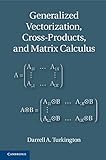Generalized vectorization, cross-products, and matrix calculus / Darrell A. Turkington, University of Western Australia.
Material type: TextPublisher: Cambridge : Cambridge University Press, 2013Edition: 1st edDescription: xi, 267 pages ; 24 cmContent type:
TextPublisher: Cambridge : Cambridge University Press, 2013Edition: 1st edDescription: xi, 267 pages ; 24 cmContent type: - text
- unmediated
- volume
- 9781107032002 (hardback)
- 515.63 23
- QA188 .T8645 2013
- BUS021000
| Item type | Current library | Call number | Status | Date due | Barcode | |
|---|---|---|---|---|---|---|
 Books
Books
|
Centeral Library Second Floor - Engineering & Architecture | 515.63 T.D.G 2013 (Browse shelf(Opens below)) | Available | 21610 |
Includes bibliographical references (pages 257-258) and index.
Machine generated contents note: 1. Mathematical prerequisites; 2. Zero-one matrices; 3. Elimination and duplication matrices; 4. Matrix calculus; 5. New matrix calculus results; 6. Applications.
"This book studies the mathematics behind matrix calculus, and the final chapter looks at applications of matrix calculus in statistics and econometrics"--
"In this chapter we consider elements of matrix algebra, knowledge of which is essential for our future work. This body of mathematics centres around the concepts of Kronecker products and vecs of a matrix. From the elements of a matrix and a matrix the Kronecker product forms a new matrix. The vec operator forms a column vector from the elements of a given matrix by stacking its columns one underneath the other. Several new operators considered in this chapter are derived from these basic operators. The operator which I call the cross product operator takes the sum of Kronecker products formed from submatrices of two given matrices. The rvec operator forms a row vector by stacking the rows of a given matrix alongside each other. The generalized vec operator forms a new matrix from a given matrix by stacking a certain number of its columns, taken as a block, under each other, and the generalized rvec operator forms a new matrix by stacking a certain number of rows, again taken as a block, alongside each other. It is well known that Kronecker products and vecs are intimately connected but this connection also holds for rvec and generalized operators as well. The cross sum operator, as far as I know, is being introduced by this book. As such, I will present several theorems designed to investigate the properties of this operator. The approach I have taken in this book is to list, without proof, well-known properties of the mathematical operator or concept in hand. If, however, I am presenting the properties of a new operator or concept, if I am presenting a property in a different light, or finally if I have something new to say about the concept, then I will give a proof"--
There are no comments on this title.

